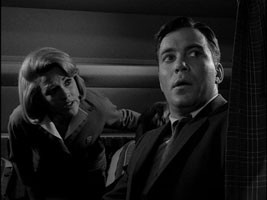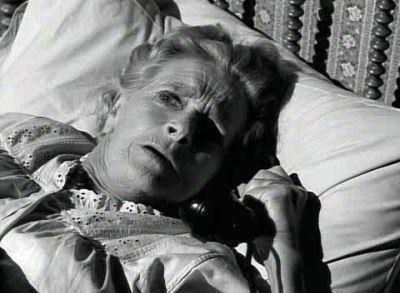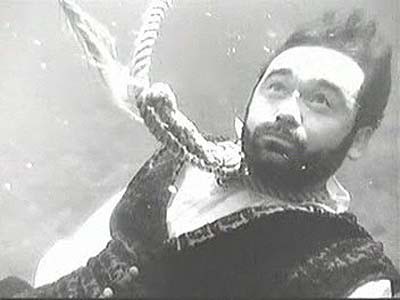| Reviews & Columns |
|
Reviews DVD TV on DVD Blu-ray 4K UHD International DVDs In Theaters Reviews by Studio Video Games Features Collector Series DVDs Easter Egg Database Interviews DVD Talk Radio Feature Articles Columns Anime Talk DVD Savant Horror DVDs The M.O.D. Squad Art House HD Talk Silent DVD
|
DVD Talk Forum |
|
|
| Resources |
|
DVD Price Search Customer Service #'s RCE Info Links |
|
Columns
|
|
|
Twilight Zone - Season 5, The
The revolving door of Twilight Zone producers, following the game-changing departure of Buck Houghton at the end of season three, resulted in other kinds of sloppiness. The overall tone of the scripts in season five disturbingly shifted away from the archetypal Twilight Zone - of small-time losers or harried white-collar executives finding validation or getting a second shot at life (as in "Walking Distance," "Passage for a Trumpet," etc.) - toward unappetizing tales of cosmic justice meted-out to loudmouths, lonely old widows, greedy adult children, boozy couples and the like. In season five even a few innocent bystanders get the bejesus scared out of them for no good reason.
Season five of Twilight Zone also shamelessly and unimaginatively recycled concepts: Season three's above average "The Dummy" became the dreary "Caesar and Me." A season one classic, "Long Live Walter Jameson," was reworked as the dreadful "Queen of the Nile." Season five's "Stopover in a Quiet Town" is like a combination of two shows: "Where Is Everybody?" and "Five Characters in Search of an Exit."
Conversely, The Twilight Zone - Season Five is interesting in other ways. For one thing veteran series directors like John Braham and Douglas Heyes generally stepped aside, making way for new-to-Twilight Zone helmers like Richard Donner, Don Siegel, Richard C. Sarafian, Alan Crosland, Jr. and others who gave the show a stylistic shot in the arm. Their shows don't quite resemble the Zones of years past.
Four of the season's 36 episodes, more than any other year, were for decades out of circulation. They've been reinstated here, and while three of the four shows - "Sounds and Silences," "A Short Drink from a Certain Fountain," and "The Encounter" - are pretty terrible, "An Occurrence at Owl Creek Bridge" is a one-of-a-kind masterpiece, an award-winning French-made film tweaked slightly and broadcast as a Zone.
As with The Twilight Zone - Season One, Season Two, Season Three, and The Twilight Zone - Season Four, the huge bump in picture quality more than justifies the cost of upgrading from their already fine DVD versions. Extras from earlier DVD editions have been ported over, including - Hoo-ray! - Mickey Rooney's surreally hilarious audio commentary on "Last Night of a Jockey." Older extras include video interviews, isolated scores, and a condescending Mike Wallace interview of Serling from 1959. All this is further supplemented with 20 new audio commentaries and 22 radio adaptations.
"Nightmare at 20,000 Feet"
Season Five's Top Five
1. "Nightmare at 20,000 Feet" by Richard Matheson - Season five's best show was, of course, later remade as a blood-and-thunder segment of Twilight Zone - The Movie (1983), but while director George Miller's film version had a better-looking monster, Richard Donner's TV version is superior for several reasons. In the movie, John Lithgow's airline passenger is a Nervous Nellie of a flyer to begin with, becoming unglued well before he spies a mischievous gremlin that he (but no one else) sees tampering with the plane's engines. It's a great wild-eyed (and, this being a George Miller film, also popeyed) performance, but everything else is overdone, too, apparently a deliberate decision to enhance Lithgow's fever-dream perspective. In the TV version, William Shatner plays a man newly released from a mental hospital following a nervous breakdown. This version is all about trying to repress the irrepressible, to not scream like a banshee amid all the normalcy around him. He vainly struggles to maintain his composure lest he be recommitted, in a postwar world ignorant and intolerant of mental illnesses. Shatner, at the peak of his anthology show era talents, is nothing less than superb. Writer Matheson always felt the show was ruined by William Tuttle's absurd monster - a panda with a scary face - but its very oddness adds to the episode's creepiness, at least for those willing to suspend a modicum of disbelief.
2. "Night Call" by Richard Matheson - Though more appropriate to Thriller than Twilight Zone this one is marvelously frightening - maybe Twilight Zone's all-time scariest. During and following a storm, a lonely if haughty spinster (Gladys Cooper) begins receiving strange, anonymous phone calls with an otherworldly voice on the other end of the line. And what a creepy voice it is! Echoes of the great Val Lewton-produced horror-fantasies of the 1940 make sense when one considers its director: Jacques Tourneur, who helmed Cat People and I Walked with a Zombie.
3. "Living Doll" by Jerry Sohl, though credited to Charles Beaumont - It's part of the pop culture lexicon now. Who doesn't know the "I'm Talky Tina and I'm going to kill you!" doll taunting abusive stepfather Telly Savalas into an early grave? It was even creepier back in 1963 when it was obvious Talky Tina was inspired by Chatty Cathy, a talking doll from Mattel that, as in the Twilight Zone episode, was voiced by the great June Foray. Savalas's casting was ingenious; he wasn't even a character star at this point yet his casual cruelty and, later, his fear-driven need to destroy his step-daughter's innocent-looking doll, is unique among Twilight Zone episodes. The show is marred by a needless mini-twist at the end, when the doll warns the Savalas's utterly innocent wife (Mary LaRoche) that she'd better watch her step, too. Or maybe Sohl was cleverly holding the wife culpable for not getting her daughter out of harm's way. Regardless, a classic show. Beaumont's health had deteriorated so profoundly that all three season five shows credited to him were written by others.
4. "You Drive" by Earl Hamner, Jr. - This episode doesn't get a lot of credit but its simplicity, lead performance, and unusual location work make it one of those Twilight Zone episodes that stays with you long after it's over. A rare Hamner script without a backwoods setting, this one has white-collar worker Ollie Pope (oily character actor Edward Andrews) the driver in a hit-and-run accident, striking the friendly newspaper boy a few blocks from his suburban home. He tries to get away with it, but his car won't let him, blaring its horn in the middle of the night, stalling out at the site of the accident, etc., as if badgering Ollie into guilt-ridden submission. Andrews, so good in films as varied as The Phenix City Story (1955) and Billy Wilder's underrated Avanti! (1972), is outstanding in this while the rare off-the-lot location work in real-world suburbia adds to its verisimilitude.
5. "Number Twelve Looks Just Like You" by John Tomerlin, based on a story by Charles Beaumont - In a seemingly utopian future society, all young adults can hardly wait to go through "the Transformation," in which their faces and bodies, chosen from a limited selection of models, are made "beautiful." For them it's idyllic, the chance to look just like one's best friend, or a mother to look as young as her daughter. However, Plain Jane Marilyn Cuberle (freckly redhead Collin Wilcox) doesn't want the procedure, seeing it as pointless and counterproductive, an attitude no one else can understand. It's a genuinely disturbing show about conformity and the pressures of society to be conventionally attractive, and its wrap-out is uniquely horrifying.
"Night Call"
Most Underrated
1. "Ring-a-Ding Girl" by Earl Hamner, Jr. - Yet another unique, non-backwoods show from future Waltons creator Hamner, this episode is curiously appealing with a central conceit not attempted on Zone before. Film star Bunny Blake, (troubled actress Maggie McNamara) makes a surprise visit to her small hometown, delighting her sister (Mary Munday). However, Bunny's behavior is a bit off, ethereal as if not entirely there and, atypically pushy, she insists on staging an impromptu, one-woman show in the local gymnasium at the same time as the town's annual picnic. It's a fascinating episode about multiple planes of existence and it refreshingly ends somewhat ambiguously, at a time when Twilight Zone more often than not was becoming thuddingly literal.
2. "The Old Man in the Cave" by Rod Serling, based on a story by Henry Slesar - Though it's let down by a disappointing Big Reveal, this post-apocalyptic tale of a small town barely hanging on ten years after a civilization-ending nuclear war, its community kept alive by the smarts of a mysterious old man in a nearby cave, has many attributes. Its depiction of a post-nuclear America is unusually realistic for '60s television and the show ends on a horribly bleak, appropriately pessimistic note. Character actor John Anderson, in his last of four Twilight Zone appearances, is very good as the town's spokesman with James Coburn excellent as the rabble-rouser threatening all.
3. "Mr. Garrity and the Graves" by Rod Serling, based on a story by Mike Korologos (but in fact probably adapted from Philip José Farmer's "Uproar in Acheron") - The last really good Twilight Zone to be broadcast is this darkly funny take on, apparently, a popular historic legend. In the Old West, traveling huckster Garrity (John Dehner) makes the town of Happiness, Arizona a startling offer: resurrected their dear departed up on Boot Hill. It's a rare show of comic finesse from Serling, who with this kind of material usually lays it on with the subtlety of a trowel and a bucket of plaster. The wonderful character actor Dehner, in his third memorable Twilight Zone appearance, also understands the material and is wryly amusing. Another good and atypical episode.
4. "The 7th Is Made Up of Phantoms" by Rod Serling - Though it reworks an old sci-fi chestnut - modern-day soldiers with modern weapons mysteriously transported backwards in time to a historic battle scene (an idea reworked yet again in movies like The Final Countdown and G.I. Samurai/Sengoku Jieitai 1549) - and despite a politically-incorrect tale of a modern-day tank crew fighting Injuns at Little Big Horn, there's something awfully appealing about this show. Partly this is a case of the show's limited budget working to its advantage. (Fifth season shows averaged around $55,000/episode to produce.) The tank crew's perspective is limited (i.e., no extras and bit players to pay for). Most of the action is happening offscreen. They're not sure at first what's going on, and are reluctant to believe it when the answer to the mystery becomes apparent. (Warren Oates's naysayer helps sell this; he's terrific.)
Most Overrated
1. " Ninety Years Without Slumbering" by Richard de Roy, based on a teleplay by George Clayton Johnson - Or: "Seniors Say the Darndest Things!" Obviously intended as a showcase for special guest star Ed Wynn, whose second career Serling launched with Requiem for a Heavyweight, this episode is unbearably syrupy and pedestrian on just about every level. Only Bernard Herrmann's original score (his last for the series) has any redeeming value. Even Johnson disliked this version.
2. "The Masks" by Rod Serling - Irritating show has crotchety dying millionaire (Robert Keith) forcing his family of losers (Milton Selzer, Virginia Gregg, Brooke Hayward, and Alan Sues) to don grotesque Cajun-crafted masks until midnight lest they lose out on their inheritance. Another one of these misguided "cosmic justice" shows muddled here because Keith's millionaire is as unlikable as his rotten family, none of whom are really deserving of the disfigurement they suffer at the hands of makeup man William Tuttle.
Twilight Turkeys
Almost too many to count. "The Fear," by Rod Serling and starring Peter Mark Richman and Hazel Court as a small town sheriff and a New York socialite. They're trapped in a cabin while apparently giant monsters from outer space lurk about outside. This goofy episode features the funniest bad dialogue this side of Ed Wood.
Earl Hamner, Jr.'s "The Bewitchin' Pool" has a great concept - unhappy children escape to a never-never land via a portal at the bottom of the family swimming pool - but the episode is ruined because the Alabaman-accented child at the center of the story (played by To Kill a Mockingbird's Mary Badham) was completely redubbed (again, by June Foray), and very badly. Too bad her original performance couldn't have been restored.
"A Kind of Stopwatch," by Serling (based on a story by Michael D. Rosenthal) botches its basic concept with silly, trivial, and illogical ideas, and like many fifth season shows a) has an unpleasant central character b) whose ultimate punishment hardly fits the crime.
Best Zone Crépuscule
"An Occurrence at Owl Creek Bridge." This was an award-winning French short film directed by Robert Enrico. Based on the famous short story by Ambrose Bierce, it takes place during the American Civil War. Union soldiers prepare to hang a Confederate spy (Peyton Farquhar) over the Owl Creek Bridge, but as he is dropped the rope snaps and the man desperately swims and runs away, ultimately hoping to reach his wife and child. Because of the American setting and the lack of significant dialogue, producer William Froug purchased television rights and the film was broadcast as a money-saving Zone. Serling introduces the film and there's a commercial break halfway through, but otherwise it's pretty much an unaltered version of the original short. It's really excellent, visually stunning with its dream-like imagery and its conclusion is genuinely devastating, even for those who remember Bierce's story from High School English class.
"An Occurrence at Owl Creek Bridge"
Video & Audio
Like previous volumes, The Twilight Zone - Season 5 looks absolutely splendiferous, offering terrific high-definition detail, all pillar-boxed to 1.37:1, from 35mm film elements showing incredibly little wear for such a perennially-printed, nearly 50-year-old television season. The inky blacks and added high-def detail really make these play almost like new theatrical features; the black and white photography is just sensational. The uncompressed PCM mono audio is likewise strong, though I'm totally satisfied with the original mono, also included. The five discs are region A encoded. Menu screens are easy to navigate. Optional English SDH subtitles are included.
Extra Features
Supplements include 20 new audio commentaries, most featuring series historian Marc Scott Zicree. Fellow film/television scholars Gary Gerani, Bill Warren, Jim Benson, Scott Skelton, and Martin Grams, Jr. join him or speak separately on various episodes. In others original cast and crew including directors Ted Post, Richard Donner, and Robert Butler; writer Earl Hamner, Jr.; and actors George Takei and Peter Mark Richman join Zicree.
Also new are archival "Conversations with Rod Serling" and a vintage audio interview with series DP George T. Clemens, as well as 22 radio adaptations featuring Beverly Garland, Louis Gossett, Jr., Bill Erwin, Kate Jackson, Stan Freberg, Jane Seymour and many others.
Older extras include previously available video interviews, bloopers, sponsor billboards, and the like.
Parting Thoughts
Though wildly inconsistent, the fifth and final season of The Twilight Zone still has its gems. These and all the other shows have never looked and sounded so good, nor have so many valuable extra features ever supported them. A DVD Talk Collector's Series title.
Stuart Galbraith IV's latest audio commentary, for AnimEigo's Musashi Miyamoto DVD boxed set, is on sale now.
|
| Popular Reviews |
| Sponsored Links |
|
|
| Sponsored Links |
|
|
| Release List | Reviews | Shop | Newsletter | Forum | DVD Giveaways | Blu-Ray | Advertise |
|
Copyright 2024 DVDTalk.com All Rights Reserved. Legal Info, Privacy Policy, Terms of Use,
Manage Preferences,
Your Privacy Choices | |||||||
















